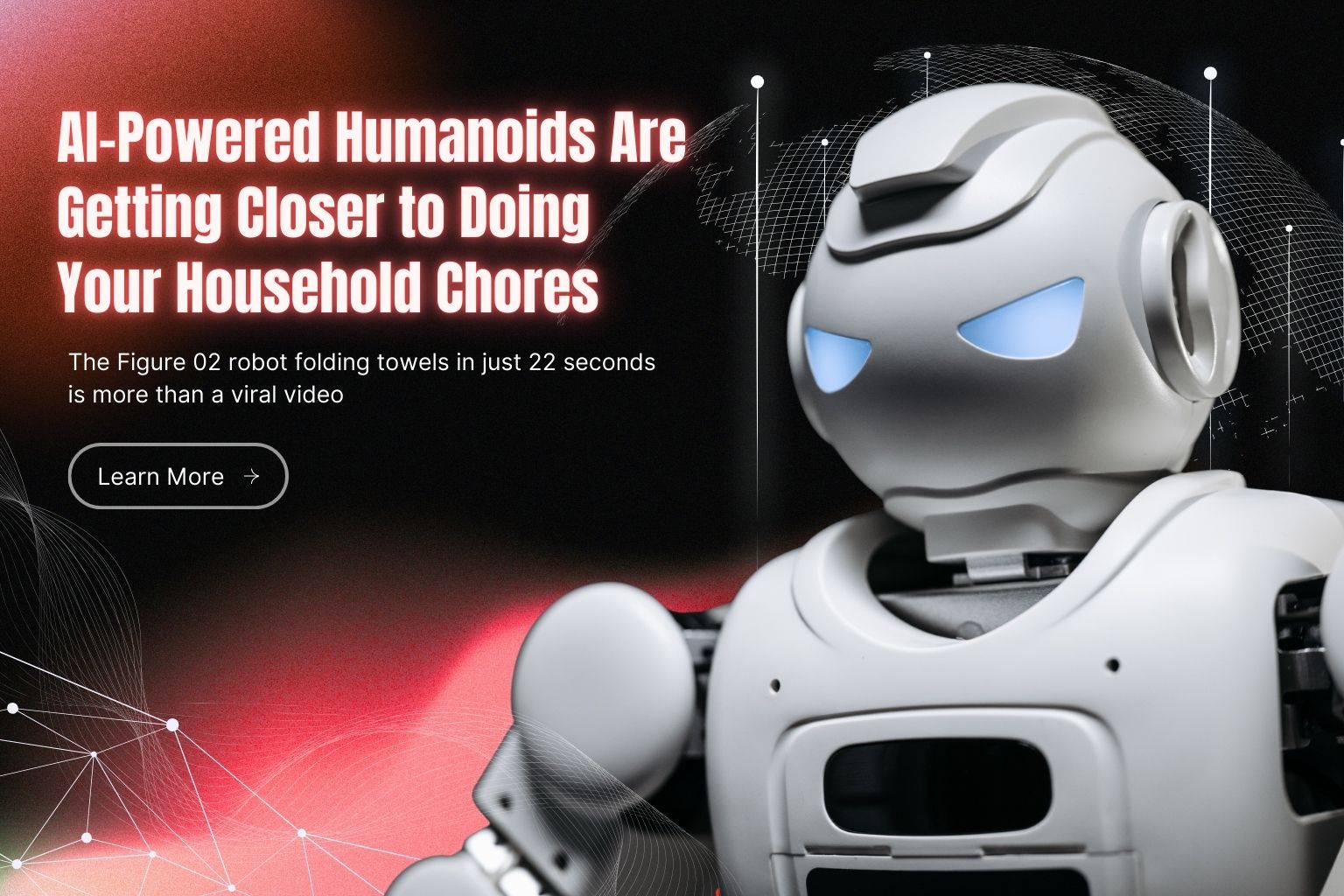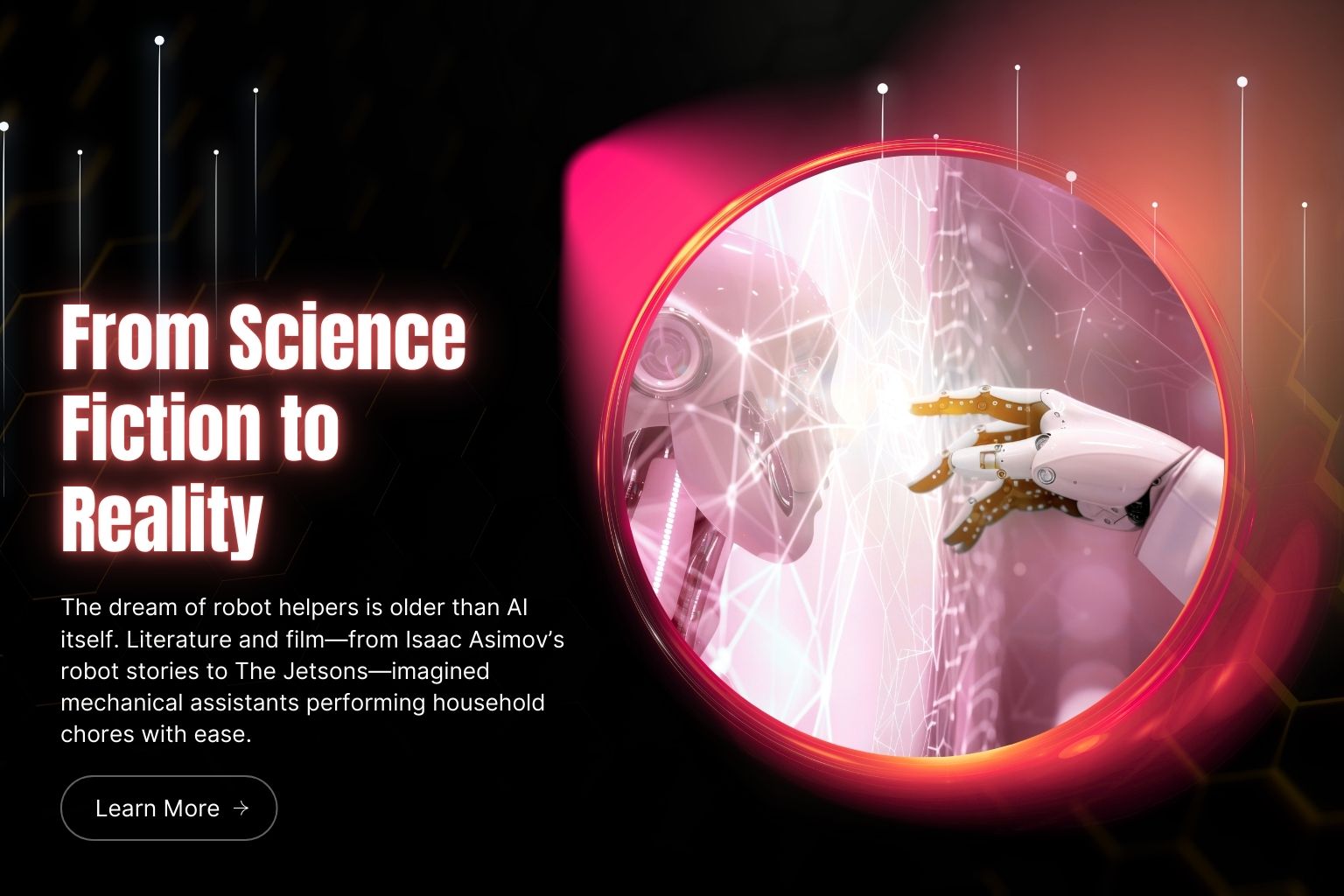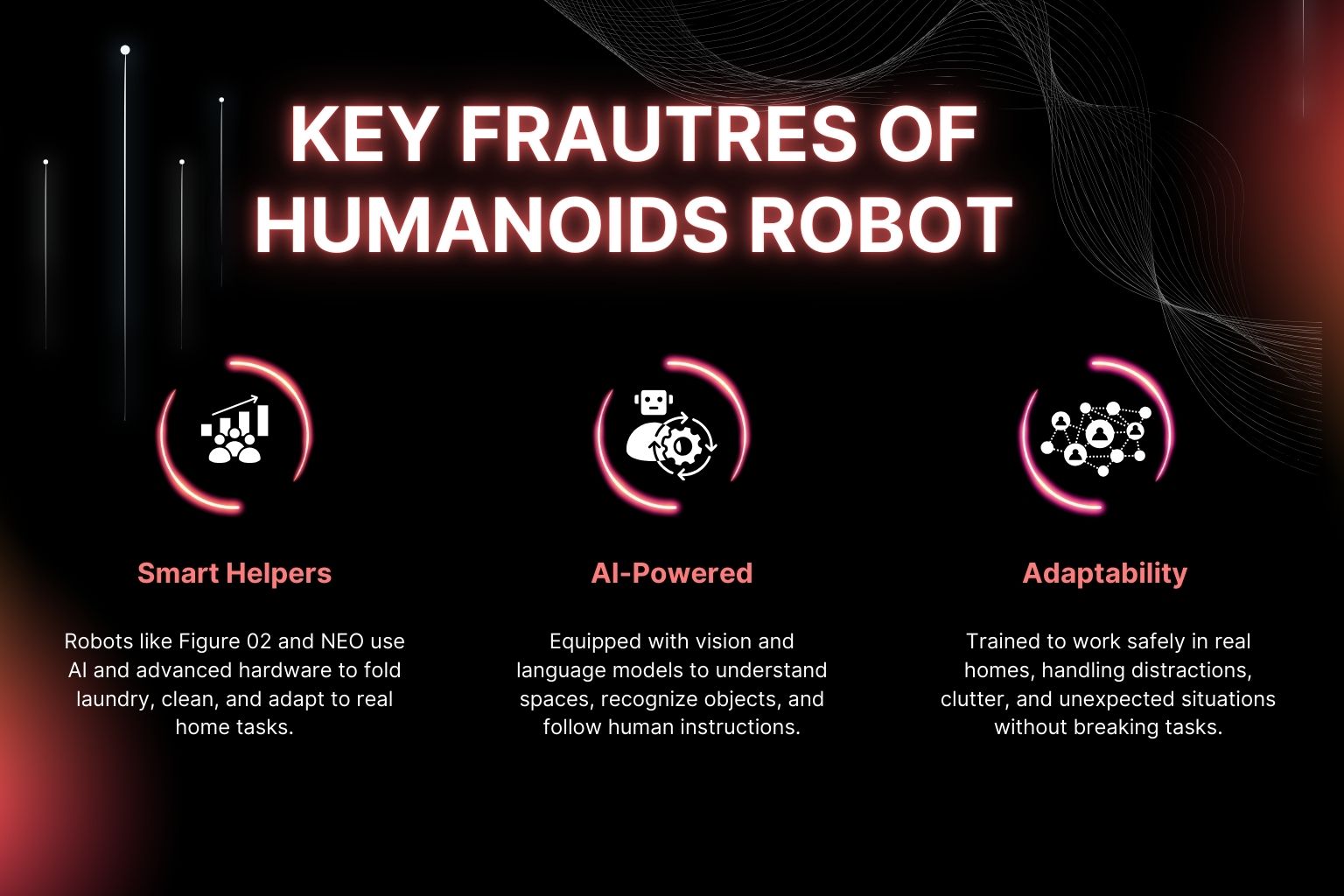AI-Powered Humanoids Are Getting Closer to Doing Your Household Chores
Smash Code
Aug 20, 2025

The Figure 02 robot folding towels in just 22 seconds is more than a viral video—it shows a turning point in robotics. For decades, robots looked impressive at tech shows but failed to fit into daily home life. Now, AI-powered humanoids like Figure 02 and NEO are proving they can manage real household chores. Challenges like speed, cost, and safety still stand in the way, but progress is undeniable. The question is no longer if robots will help at home, but when—and that may be sooner than we think.
Imagine walking into your living room after a long day, only to find your laundry neatly folded and your washing machine already loaded—courtesy of a humanoid robot. What once seemed like science fiction is edging toward reality, as artificial intelligence (AI) and robotics advance at a breathtaking pace.
A recent demonstration from California-based Figure AI sparked global attention: its Figure 02 humanoid robot folded six towels, averaging just 22 seconds per towel. Another video from CEO Brett Adcock showed the same robot crouching and carefully loading clothes into a washing machine, even handling interference from a child playfully tossing extra laundry into the drum.
According to CNET, the demo highlights how far humanoid robots have come in mastering everyday domestic tasks once thought too complex for machines. And Figure isn’t alone. The Norwegian robotics company 1X Technologies recently unveiled its humanoid model, NEO, capable of carrying laundry baskets, serving coffee, and tidying homes.
These advances reignite debate: Will humanoid robots soon become as common in homes as vacuum cleaners or dishwashers?
To answer, let’s explore their history, industry progress, current limits, and what the future holds.
A Brief History of Humanoid Robots

The dream of robot helpers is older than AI itself. Literature and film—from Isaac Asimov’s robot stories to The Jetsons—imagined mechanical assistants performing household chores with ease.
In real life, the late 20th and early 21st centuries gave us glimpses of humanoid potential. Honda’s ASIMO, unveiled in 2000, wowed audiences by climbing stairs, kicking soccer balls, and responding to voices. Despite its charm, ASIMO never left the research lab—it was too costly and too limited for practical use.
Attempts at more targeted domestic robots emerged too. One notable case was FoldiMate, a machine dedicated to folding laundry. Hailed as the “end of laundry day” when first shown at CES 2012, FoldiMate ultimately shut down in 2021 before reaching consumers (Wikipedia). The project revealed a harsh truth: creating reliable, affordable robots that handle messy, unpredictable household environments is much harder than making lab demos.
What has changed recently is the rise of AI-powered humanoids—robots with flexible software and dexterous hardware, designed not for one fixed task but to adapt dynamically to human environments.
Figure AI and 1X Technologies
Figure AI and Figure 02
Founded in 2022 by entrepreneur Brett Adcock, Figure AI quickly became one of the most-watched robotics startups. Its first robot, Figure 01, targeted logistics and industrial roles. But the real breakthrough came with Figure 02, unveiled in 2024.
This humanoid is built with six RGB cameras for vision, a powerful AI brain powered by NVIDIA GPUs, and 16 degrees of freedom in its hands, enabling precise manipulation. It can lift up to 25 kilograms, walk stably, and—crucially—perform household tasks with autonomy.
The towel-folding and laundry-loading demonstrations showcased not just mechanical ability but also decision-making. Figure 02 runs on an advanced Vision-Language-Action (VLA) model called Helix, co-developed with OpenAI, allowing it to perceive objects, understand instructions, and act accordingly (Futurism, Notebookcheck).
The machine’s ability to handle distractions—like a child tossing clothes—underscores its adaptability in chaotic, real-world homes. This represents a leap forward from rigidly programmed robots of the past.
1X Technologies and NEO
On the other side of the Atlantic, Norwegian company 1X Technologies (formerly Halodi Robotics) has made headlines with its NEO humanoid robot.
- NEO Beta, launched in 2024, is about 5.4 feet tall, weighs 66 pounds, and uses tendon-driven actuators that mimic muscle movements. It can carry up to 44 pounds, walk at 2.5 mph, and even sprint short distances at 7.5 mph.
- In 2025, NEO Gamma was revealed with further refinements: a soft knit exterior, expressive “earrings” for emotions, improved locomotion (it can squat, sit, and pick up items), and conversational AI for natural interaction (Newsweek, MyModernMet).
Videos show NEO Gamma serving coffee, vacuuming, carrying laundry baskets, and even delicately handling wine bottles. The company envisions these robots as not just helpers, but companions that blend safety, utility, and personality.
Backed by over $100 million in Series B funding (with support from OpenAI), 1X has ambitious goals: pilot programs in hundreds of homes by 2025, scaling to millions of units by 2028 (The Sun).
Why Now? The Tech Behind Humanoid Robots Progress

Three factors explain why humanoids are finally tackling household chores with promise:
- Smarter AI Models – Vision-language-action models like Helix allow robots to interpret messy environments, understand verbal instructions, and make real-time decisions.
- Improved Hardware – Lightweight frames, tendon-like actuators, and dexterous five-fingered hands enable safe, human-like motion. Soft exteriors (like NEO’s knit suit) reduce safety risks and noise.
- Embodied Intelligence Training – Robots are increasingly trained in simulated and real environments, allowing them to adapt to cluttered homes rather than perfect lab settings.
Together, these innovations transform robots from rigid automatons into flexible, context-aware assistants.
What Can Today’s Robots Actually Do?
The recent demos reveal a growing list of household tasks robots can handle:
- Laundry – Folding towels, loading washing machines, carrying baskets.
- Cleaning – Vacuuming floors, picking up items, tidying rooms.
- Serving & Handling – Pouring coffee, carrying drinks, setting tables.
- General Assistance – Fetching objects, holding items, and moving small loads.
These may sound modest, but household chores are time-consuming. A robot that reliably folds laundry or vacuums could free hours each week for busy families.
Industrial partnerships add credibility: Figure has worked with BMW to deploy humanoids in manufacturing (Wikipedia). Skills learned on factory floors—sorting, lifting, carrying—translate directly into domestic tasks.
The Limits of Household Robots
Despite the buzz, humanoid robots remain far from perfect. Key challenges include:
- Task Scope: Robots can fold towels but struggle with delicate fabrics, varied garment shapes, or appliances with different interfaces.
- Speed: Folding a towel in 22 seconds is slower than most humans. Tasks like sorting laundry or cleaning kitchens may still take too long to be practical.
- Battery Life: NEO Beta operates just 2–4 hours before needing a recharge, limiting its usefulness in busy households.
- Cost: Both Figure and 1X expect early robots to cost as much as an affordable car—still too expensive for most families.
- Safety: Heavy robots operating around children and pets raise concerns, though soft designs and strict safety protocols help mitigate risks.
- Privacy & Trust: Robots with cameras and microphones in private spaces spark debate over data security and social acceptance.
These limits mean domestic humanoids remain early-stage technology—impressive for demos, but not yet ready to replace human effort at scale.
Looking Ahead: The Future of Household Robots
Despite hurdles, the trajectory is clear: humanoids are moving from factories to homes. What might the next decade look like?
- Expanded Skills – Beyond laundry, robots will cook basic meals, clean kitchens, make beds, and handle groceries.
- Integration with Smart Homes – Connected robots will coordinate with appliances, thermostats, and voice assistants for seamless automation.
- Accessibility Benefits – For elderly or disabled individuals, humanoids could provide life-changing support—fetching items, preventing falls, and offering companionship.
- Faster, Cheaper Models – As hardware improves and production scales, robots could reach price points similar to premium appliances.
- Mass Adoption – 1X’s roadmap predicts millions of household robots by 2028. If realised, this would mark the fastest adoption of humanoids in history.
- Ethical & Social Shifts – Society must address privacy, liability, and job displacement. Yet, as with smartphones, scepticism may fade once people experience convenience firsthand.
Imagine waking up in 2030 to find your humanoid has already brewed coffee, packed school lunches, vacuumed the living room, and started the laundry. Such a scene may no longer feel like fantasy.
A Future Within Reach
The Figure 02 folding towels in 22 seconds is more than a viral clip—it symbolises a turning point. For decades, robots dazzled on stage but disappointed in homes. Today, powered by AI, humanoids like Figure 02 and NEO are crossing that gap, proving they can handle messy, unpredictable chores.
Yes, limitations remain: speed, cost, and safety are hurdles. But progress is undeniable. What was once sci-fi is now unfolding in labs, factories, and living rooms worldwide.
The question is no longer if humanoid robots will help with household chores—it’s when. And if companies like Figure AI and 1X deliver on their ambitious roadmaps, that “when” could be sooner than most of us expect.
So next time you fold laundry, consider: you might not be the one doing it in just a few years.
Sources
- CNET – Figure 02 Towel Folding Demo
- Futurism – Humanoid Robot Loading Washing Machine
- Notebookcheck – Figure 02 Demonstrates Laundry Skills
- Housebots – Figure 02 Household Tasks
- Wikipedia – Figure AI
- Newsweek – 1X NEO Beta
- The Sun – 1X Roadmap and Funding
- MyModernMet – NEO Humanoid Robot
- Indian Express – NEO Gamma Household Demos
- LiveScience – NEO Gamma Household Roles